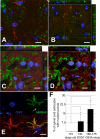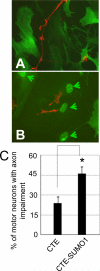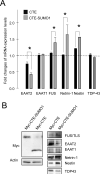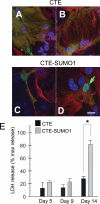Motor neuron impairment mediated by a sumoylated fragment of the glial glutamate transporter EAAT2
- PMID: 21769946
- PMCID: PMC3896305
- DOI: 10.1002/glia.21218
Motor neuron impairment mediated by a sumoylated fragment of the glial glutamate transporter EAAT2
Abstract
Dysregulation of glutamate handling ensuing downregulation of expression and activity levels of the astroglial glutamate transporter EAAT2 is implicated in excitotoxic degeneration of motor neurons in amyotrophic lateral sclerosis (ALS). We previously reported that EAAT2 (a.k.a. GLT-1) is cleaved by caspase-3 at its cytosolic carboxy-terminus domain. This cleavage results in impaired glutamate transport activity and generates a proteolytic fragment (CTE) that we found to be post-translationally conjugated by SUMO1. We show here that this sumoylated CTE fragment accumulates in the nucleus of spinal cord astrocytes of the SOD1-G93A mouse model of ALS at symptomatic stages of disease. Astrocytic expression of CTE, artificially tagged with SUMO1 (CTE-SUMO1) to mimic the native sumoylated fragment, recapitulates the nuclear accumulation pattern of the endogenous EAAT2-derived proteolytic fragment. Moreover, in a co-culture binary system, expression of CTE-SUMO1 in spinal cord astrocytes initiates extrinsic toxicity by inducing caspase-3 activation in motor neuron-derived NSC-34 cells or axonal growth impairment in primary motor neurons. Interestingly, prolonged nuclear accumulation of CTE-SUMO1 is intrinsically toxic to spinal cord astrocytes, although this gliotoxic effect of CTE-SUMO1 occurs later than the indirect, noncell autonomous toxic effect on motor neurons. As more evidence on the implication of SUMO substrates in neurodegenerative diseases emerges, our observations strongly suggest that the nuclear accumulation in spinal cord astrocytes of a sumoylated proteolytic fragment of the astroglial glutamate transporter EAAT2 could participate to the pathogenesis of ALS and suggest a novel, unconventional role for EAAT2 in motor neuron degeneration.
Copyright © 2011 Wiley-Liss, Inc.
Figures








Similar articles
-
Sumoylation of the astroglial glutamate transporter EAAT2 governs its intracellular compartmentalization.Glia. 2014 Aug;62(8):1241-53. doi: 10.1002/glia.22677. Epub 2014 Apr 21. Glia. 2014. PMID: 24753081 Free PMC article.
-
A caspase-3-cleaved fragment of the glial glutamate transporter EAAT2 is sumoylated and targeted to promyelocytic leukemia nuclear bodies in mutant SOD1-linked amyotrophic lateral sclerosis.J Biol Chem. 2007 Nov 2;282(44):32480-90. doi: 10.1074/jbc.M704314200. Epub 2007 Sep 6. J Biol Chem. 2007. PMID: 17823119
-
Mutation of the caspase-3 cleavage site in the astroglial glutamate transporter EAAT2 delays disease progression and extends lifespan in the SOD1-G93A mouse model of ALS.Exp Neurol. 2017 Jun;292:145-153. doi: 10.1016/j.expneurol.2017.03.014. Epub 2017 Mar 22. Exp Neurol. 2017. PMID: 28342750 Free PMC article.
-
Protein SUMOylation, an emerging pathway in amyotrophic lateral sclerosis.Int J Neurosci. 2013 Jun;123(6):366-74. doi: 10.3109/00207454.2012.761984. Epub 2013 Feb 4. Int J Neurosci. 2013. PMID: 23289752 Review.
-
Sumoylation of critical proteins in amyotrophic lateral sclerosis: emerging pathways of pathogenesis.Neuromolecular Med. 2013 Dec;15(4):760-70. doi: 10.1007/s12017-013-8262-x. Epub 2013 Sep 24. Neuromolecular Med. 2013. PMID: 24062161 Free PMC article. Review.
Cited by
-
Sumoylation of the astroglial glutamate transporter EAAT2 governs its intracellular compartmentalization.Glia. 2014 Aug;62(8):1241-53. doi: 10.1002/glia.22677. Epub 2014 Apr 21. Glia. 2014. PMID: 24753081 Free PMC article.
-
SETX sumoylation: A link between DNA damage and RNA surveillance disrupted in AOA2.Rare Dis. 2014 Jan 21;2:e27744. doi: 10.4161/rdis.27744. eCollection 2014. Rare Dis. 2014. PMID: 25054092 Free PMC article.
-
The impact of proteostasis dysfunction secondary to environmental and genetic causes on neurodegenerative diseases progression and potential therapeutic intervention.Environ Sci Pollut Res Int. 2020 Apr;27(11):11461-11483. doi: 10.1007/s11356-020-07914-1. Epub 2020 Feb 19. Environ Sci Pollut Res Int. 2020. PMID: 32072427 Review.
-
Oxidative Stress in Neurodegenerative Diseases: From Molecular Mechanisms to Clinical Applications.Oxid Med Cell Longev. 2017;2017:2525967. doi: 10.1155/2017/2525967. Epub 2017 Jul 12. Oxid Med Cell Longev. 2017. PMID: 28785371 Free PMC article. Review.
-
Astrocytes drive upregulation of the multidrug resistance transporter ABCB1 (P-Glycoprotein) in endothelial cells of the blood-brain barrier in mutant superoxide dismutase 1-linked amyotrophic lateral sclerosis.Glia. 2016 Aug;64(8):1298-313. doi: 10.1002/glia.23003. Epub 2016 May 9. Glia. 2016. PMID: 27158936 Free PMC article.
References
-
- Acarin L, Villapol S, Faiz M, Rohn TT, Castellano B, Gonzalez B. Caspase-3 activation in astrocytes following postnatal excitotoxic damage correlates with cytoskeletal remodeling but not with cell death or proliferation. Glia. 2007;55(9):954–65. - PubMed
-
- Bernardi R, Pandolfi PP. Structure, dynamics and functions of promyelocytic leukaemia nuclear bodies. Nat Rev Mol Cell Biol. 2007;8(12):1006–16. - PubMed
-
- Blackburn D, Sargsyan S, Monk PN, Shaw PJ. Astrocyte function and role in motor neuron disease: a future therapeutic target? Glia. 2009;57(12):1251–64. - PubMed
-
- Boston-Howes W, Gibb SL, Williams EO, Pasinelli P, Brown RH, Jr., Trotti D. Caspase-3 cleaves and inactivates the glutamate transporter EAAT2. J Biol Chem. 2006;281(20):14076–84. - PubMed
Publication types
MeSH terms
Substances
Grants and funding
LinkOut - more resources
Full Text Sources
Molecular Biology Databases
Research Materials
Miscellaneous

